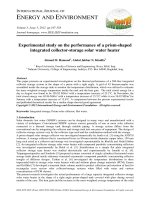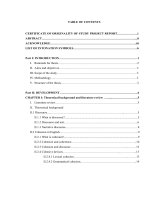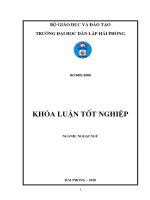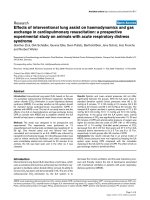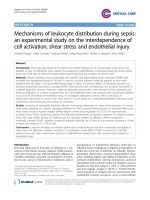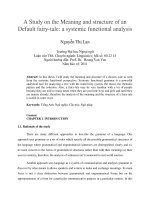Experimental study on flow kinematics and sediment transport under orthogonal wave current interaction
Bạn đang xem bản rút gọn của tài liệu. Xem và tải ngay bản đầy đủ của tài liệu tại đây (2.84 MB, 279 trang )
EXPERIMENTAL STUDY ON FLOW KINEMATICS AND
SEDIMENT TRANSPORT UNDER ORTHOGONAL
WAVE-CURRENT INTERACTION
M. PRADEEP CHAMINDA FERNANDO
NATIONAL UNIVERSITY OF SINGAPORE
2006
EXPERIMENTAL STUDY ON FLOW KINEMATICS AND
SEDIMENT TRANSPORT UNDER ORTHOGONAL
WAVE-CURRENT INTERACTION
M. PRADEEP CHAMINDA FERNANDO
(B.Sc.Eng. (Hons.), University of Peradeniya, Sri Lanka)
A THESIS SUBMITTED FOR THE DEGREE OF
DOCTOR OF PHILOSOPHY
DEPARTMENT OF CIVIL ENGINEERING
NATIONAL UNIVERSITY OF SINGAPORE
2006
Dedicated with love and gratitude
to
my parents
Your hard work and all commitments are for my successes
i
ACKNOWLEDGEMENTS
First of all, I offer my heartfelt thanks for my god Jesus Christ for giving me
the wisdom, strength and finally directing me to the end to succeed in higher studies.
I would like to express my sincere and deepest gratitude to my supervisor,
Asst. Prof. John Guo for assisting me in the Ph.D. study. Your valuable advice,
suggestions and continuous guidance provided to complete my study are highly
appreciated. Also I would be very much grateful to Prof. Cheong Hin Fatt the
chairman of my thesis advisory committee and Assoc. Prof. Lin Pengzhi for helping
me with all the suggestions and comments to progress with my experimental study. Dr.
Wu Yongsheng, thank you for your help during your stay in NUS. Also I must thank
Prof. Albert Williams and Todd Morrison for sharing some field data for the study. I
am also grateful to the civil engineering department selection committee for giving me
an opportunity to study at NUS and also for providing me with financial assistance.
Mr. Krishna, Mr. Ooh Sing Hua, Mr. Martin, Mrs. Norela, Mr. Semawi and
Mr. Roger thank you very much for your continuous support specially during the set-
up of experiment. Thanks are extended to hydraulics group friends Dr. Liu,
ChuanJiang, DongChao, Zhang Dan, XioHui, Didi, DongMing, WenYu, HaoLiang,
QuangHong and others for their support and friendship. I specially grateful to Edgar
for being a very good friend for me during my stay at NUS and for all your kind
supports.
ii
My deepest gratitude and love to you my parents and all my family members.
My parents late Mr. Hamilton Fernando and Mrs. Malani Fernando, I am indebted to
you for all your support and endless love. I know that you dedicated your life lot with
continuous hard work, emotional commitments and unforgettable sacrifices to educate
your children. Dear mother you are the one who made your children’s life success and
here, I do sincerely memorize everything adoringly. My parents in law late Mr. Joseph
Fernando and Mrs. Allen Obris, my sincere gratitude is for you for your kindness, love
and support. Father and father in law, I dearly remember, with heartfelt sorrow, your
sudden death before completing my studies. My wife Sithara, my deepest thanks to
you for supporting me throughout with love, understanding and constant
encouragement. My dearest daughter Shamary Duwa, you are the gift from heaven, I
thank you my new born for making us very happy. I also remember my elder sister
Chanika, brother in law Lakshman Aiya, Hirusha Putha, Hirushi Duwa, younger sister
Ashika and Nona Ranjanee for your love and all your support for my studies. Special
thanks to my brothers in law Dilak, Demian and Nalaka for care you extended to my
parents during my stay in Singapore.
I am especially thankful to my wife Sithara and Anu for helping me to correct
the thesis. Without your support I would not be able to complete this on time. My Sri
Lankan friends Shameen, Dulakshi, Dammika, Dumindu, Buddhi, OG, Lesly,
Namunu, Kumara, Lakshan, GC, Prabath, Ravi, Sidanths, Damitha, Predipika,
Ananda, Jagath, Nadasiri, Thushara, Indika, Lalith, Herath and others you all made
Singapore a home, accept my big thanks for your friendship and support.
iii
TABLE OF CONTENTS
Page
Acknowledgements i
Table of contents iii
Summary vii
Nomenclature x
List of figures xiv
List of tables xix
CHAPTER 1 INTRODUCTION 1
1.1 Wave-current interaction 1
1.2 Sediment transport 7
1.3 Objectives 13
1.4 Outline of the thesis 15
CHAPTER 2 REVIEW OF LITERATURE 16
2.1 Theoretical work on combined wave-current flow 16
2.1.1 Flow kinematics 18
2.1.1.1 Analytical solutions (wave effects on currents) 18
2.1.1.2 Numerical models (wave effects on currents) 22
2.1.1.3 Surface Parameters of combined flow 22
2.1.2 Bed dynamics 24
2.1.2.1 Bed shear stresses and flow regimes 24
2.1.2.2 Ripple geometry and sediment motion 26
2.2 Laboratory Experiments 30
2.2.1 Co-linear wave-current flow experiments 31
2.2.2 Arbitrary angle wave-current flow experiments 33
2.3 Field measurements 36
iv
2.3.1 Non-storm conditions 36
2.3.2 Storm conditions 37
2.4 Summary 38
CHAPTER 3 EXPERIMENTAL FACILITY AND INSTRUMENTATIONS 40
3.1 Acoustic Doppler Velocimeter (ADV) 40
3.2 PV-07 Electronic bed profile indicator 42
3.3 KENEK capacitance type wave height meter 45
3.4 Wave generation system 47
3.5 Wave basin carriage 47
3.6 Flow meter, Oscilloscope and WaveBook data acquisition system 48
CHAPTER 4 EXPERIMENTAL SET-UP 50
4.1 Experimental set-up over fixed and movable beds 50
4.1.1 Generation of currents 53
4.1.2 Wave generation 54
4.1.3 Wave Absorbers and movable bed 56
4.2 Validations of experimental set-up and preliminary justifications of
flow conditions 57
4.2.1 Pure current flow 58
4.2.1.1 Steady and uniform flow check across the current
channel 58
4.2.1.2 Current directional velocity distribution 59
4.2.1.3 Bed shear stress and sediment motion 62
4.2.2 Pure waves 62
4.2.2.1 Wave height distributions in the basin and wave
reflection 63
v
4.2.2.2 Three directional velocities and comparison to linear
wave theory 66
4.2.3 Combined wave-current flow 67
4.2.3.1 Cross-wave analysis 68
4.2.3.2 Wave height distribution in the wave-current
interaction area 68
4.2.3.3 Three directional velocities 70
4.2.3.4 Sediment settling in the wave-free zone 72
4.3 Experimental procedure 72
4.3.1 Wave-current interaction over the fixed bed 72
4.3.2 Wave-current interaction over the movable bed 73
CHAPTER 5 EXPERIMENTAL RESULTS AND DISCUSSION
(CONCRETE BED)
75
5.1 Eddy-viscosity structure of wave-current orthogonal interaction 75
5.2 Water surface parameters of orthogonal wave-current flow 83
CHAPTER 6 BED GEOMETRY AND SEDIMENT TRANSPORT
(MOVABLE BED EXPERIMENT)
88
6.1 Pure wave flow 88
6.1.1 Vortex Ripples’ Geometry 92
6.1.2 Effective bed roughness scale ripples formed by pure waves 98
6.2 Combined wave-current flow 103
6.3 Sediment transport under wave-current orthogonal motion 109
vi
CHAPTER 7 WAVE EFFECTS ON CURRENTS
(MOVABLE BED EXPERIMENT)
112
7.1 Pure current over plane sand bed 112
7.2 Pure current over ripples formed by combined wave-current flow 116
7.3 Combined wave-current flow over the movable bed 118
7.3.1 Current directional velocity distribution 122
7.3.2 Bed shear stress and hydraulic roughness height 128
7.3.3 Comparison of experimental measurements with existing
theoretical models and suggestions to modify the models 131
7.3.3.1 Christoffersen and Jonsson (1985), Fredsǿe (1984)
models 132
7.3.3.2 Grant and Madsen (1986) model 139
CHAPTER 8 AN ANALYTICAL SOLUTION ON WAVE-CURRENT
FLOW AT AN ARBITRARY ANGLE
145
8.1 Introduction on past wave-current models 145
8.2 Bed shear stress under combined wave-current action 151
8.3 Calculation procedure 161
CHAPTER 9 VALIDATION OF THE PRESENT MODEL 164
9.1 Model predictions in comparison to the field measurements 164
9.1.1 Drake et al. (1992) (Northern California shelf) 164
9.1.2 Huntley and Hazen (1988) (Nova Scotia shelf, Canada) 168
9.1.3 Cacchione et al. (1987) (Russian river shelf) 171
9.1.4 Grant et al. (1984) (Northern California shelf) 173
9.1.5 Larsen et al. (1981) (Washington, Australian shelf) 175
9.2 Model predictions in comparison to the laboratory measurements 179
vii
9.2.1 Present experiment (
0
90
φ
= ) 179
9.2.2 Kemp and Simons (1982, 1983), Bakker and van Doorn
(1978) (
00
0 , 180
φ
= ) 186
9.2.3 Sleath (1990) (
0
90
φ
= ) 190
CHAPTER 10 CONCLUSIONS AND RECOMMENDATIONS
193
10.1 Experimental set-up 193
10.2 Effects of waves on pure currents 194
10.3 Effects of current on pure waves 195
10.4 Validation and modification of theoretical models 196
10.5 Present theory 199
10.6 Bed ripple geometry and sediment transport 201
10.7 Limitations and suggestions for future work 202
References 205
Appendix A Wave Reflection and Cross-Wave Analysis 221
Appendix B Suspended Sediment Motion in the Wave Free Zone 227
Appendix C Estimation of Nikuradse’s Equivalent Sand Roughness and
Determination of Flow Regimes 229
Appendix D Estimation of Critical Depth Averaged Velocity to Produce
Non-Eroded Sand Bed 231
Appendix E Sieve Analysis of Sediment 233
Appendix F MATLAB Program for Present Model for a Reference Current 235
Appendix H Wave Height Distribution in the Combined Wave - Current Flow 236
Appendix I Measurements of Current Directional Mean Velocity Distribution
in Pure Current and Combined Wave-Current Flows 239
List of publications 254
viii
SUMMARY
With different orientations, waves co-exist with currents on continental
shelves. Effects of combined wave-current flow on many coastal practices are
significant and therefore, during the past four decades many researchers have
contributed experimentally and theoretically to the understanding of wave-current
interaction mechanisms.
This thesis presents an experimental investigation of orthogonal wave-current
flow. The study was motivated by the facts that most of the previous experimental
studies on combined wave-current flow have been conducted for parallel wave-current
conditions and theoretical models lack validation for 90
0
wave-current motions. The
purpose of this study was to investigate flow kinematics and sediment transport
experimentally for orthogonal wave-current flow to validate existing theories and to
develop a new theoretical model to describe wave-current flow at arbitrary angle
interactions. A physical model was constructed in a 3-D wave basin to reproduce
orthogonal wave-current flow over both the flat concrete and movable sand bed.
Experimental runs were conducted for pure currents, pure waves and combined wave-
current flows for the measurements of three directional velocities, water surface
elevations, bed profile geometries, suspended sediment concentrations and total
sediment transport.
The presence of waves significantly deviated the pure current velocity profile.
Near bed pure current velocities were reduced by the action of orthogonal waves due
to increase of roughness height (apparent roughness) which was experienced by the
current. On the other hand, pure wave sediment suspension was increased, wave length
was unchanged and ripple parameters (height and length) were reduced by the
ix
presence of currents. With the increase of both wave and current strengths the straight
crested ripple formation changed to serpentine and then to honeycomb patterns. Pure
current did not transport the sediment while combined wave-current action
significantly transported the sediment with the largest contribution resulted from
suspension. Due to lack of experimental data, except for 0
0
, 180
0
angle wave-current
flow, these measurements are valuable especially to study the effect of both movable
bed and interaction angle on behaviours of combined flow mechanisms.
The present experiment validates the theoretical models for the condition of 90
0
wave-current interactions. Grant and Madsen’s (1986) theory better accords with the
present experimental results, in comparison to other available models which describe
arbitrary angle wave-current flows. Some modifications for these theoretical models
are proposed to better describe orthogonal wave-current interaction. The method of
Bijker (1971) accords with measurements of suspension and current related sediment
transport quantity under orthogonal wave-current flow.
Based on time-variant bed shear stress of the combined flow, a new theory is
developed to describe the interaction of waves and currents at arbitrary angles under
any turbulent flow regime. An excellent agreement was found between the present
model and laboratory and field measurements. For most of the laboratory and field
measurements, the present theory gave the best prediction in comparison to other
available models. Most of the field data are better compatible with the present theory
in comparison to the predictions by Grant and Madsen’s (1979) theory. The present
model can be applied on continental shelf under non-eroded flow or typically stormy
conditions to study the flow behaviours of wave-current flows.
x
NOMENCLATURE
ave = Averaged value of a parameter
i
a = Incident wave amplitude
r
a = Reflected wave amplitude
0
a = Amplitude of near-bed wave orbital motion
ADV = Acoustic Doppler Velocimeter
b = Empirical coefficient, Equation 8.29
c = Wave reflection coefficient
COV = Coefficient of variance
50
d = Diameter of median sediment particle size
90
d = Sediment diameter which 90% by weight is finer in sieve analysis
s
d = Diameter of suspended sediment
D
∗
= Particle parameter, Equation D5
,wwc
f
= Friction coefficient associated with the wave component of the
combined flow
g = Acceleration due to gravity (
2
9.81ms )
h
= Water depth
H = Wave height
k = Wave number
,
nb
kk = Nikuradse’s equivalent sand roughness height
,
na ba
kk = Nikuradse’s equivalent apparent roughness height
g
k = Nikuradse’s equivalent grain roughness height
f
k = Nikuradse’s equivalent form roughness height
xi
l = Thickness of wave-dominated layer
L = Wave length
m = See Equations 8.8, 8.9
p
= Fluid pressure
,,tcwc
q = Current related total sediment transport rate of wave-current flow
r
= Model constant (Christoffersen and Jonsson (1985))
rms = Root-mean-square value
2
R
= Coefficient of determination value in linear regression
R
∗
= Grain Reynolds number
s = Specific density of sediment 2.65
≈
T = Wave period
0
u = Maximum near-bed wave velocity
,
c
uu = Pure current velocity
,cwc
u = Current velocity in wave-current combined flow
r
u = Reference current velocity of wave-current combined flow
c
u
∗
= Pure current bed shear (friction) velocity
,cwc
u
∗
= Current shear (friction) velocity associated with current component
in the combined wave-current flow
,wm pw
u
∗
= Pure wave bed shear (friction) velocity
,wcm wc
u
∗
= Shear (friction) velocity associated with maximum bed shear stress of
wave-current combined flow
,
c
UU = Magnitude of depth averaged pure current velocity
,cwc
U = Magnitude of depth averaged current velocity in wave-current flow
0
w = Median diameter particle fall velocity
xii
s
w = Particle fall velocity of suspended sediment
x
= Wave propagating direction
y = Current direction (perpendicular to
x
direction)
z = Height above the sediment bottom
r
z = Reference height above the bottom
0
z = Physical bottom roughness height
0a
z = Apparent roughness height
β
= Model constant (Christoffersen and Jonsson, 1985)
δ
= Phase shift between two probes
wc
δ
= Thickness of wave-current boundary layer
Δ = Dimensionless probe spacing k
λ
=
r
Δ = Pure wave formed ripple height
,rwc
Δ = Combined wave-current flow formed ripple height
ε
= Eddy viscosity
κ
= Von Karman’s constant
(
)
0.4=
λ
= Distance between two probes
r
λ
= Pure wave formed ripple length
,rwc
λ
= Combined wave-current flow formed ripple length
ν
= Kinematic viscosity of fluid
c
ν
= Eddy viscosity felt by current component in combined flow
w
ν
= Eddy viscosity felt by periodic component in combined flow
ρ
= Density of water
s
ρ
= Density of sediment
xiii
,pw t
τ
= Pure wave flow bed shear stress at time t
pw
τ
= Maximum bed shear stress of pure wave
pc
τ
= Bed shear stress of pure current
,, ,bwwct
τ
= Wave associated bed shear stress in wave-current flow at time t
,,bwwc
τ
= Maximum wave associated bed shear stress in wave-current flow
,,bwct
τ
= Combined wave-current flow bed shear stress at time t
,bwc
τ
= Maximum bed shear stress of wave-current combined flow
,,bcwc
τ
= Current associated bed shear stress of wave-current flow
φ
= Wave-current interaction angle
ψ
= Shields function, mobility parameter
ω
= Wave angular frequency
a
ω
= Absolute angular frequency
()
EX
= Experimental value
()
TH
= Theoretical value
()
1 q
= Averaged value of a highest
1 q
of the variable
= Periodic component
′
= Fluctuating component
xiv
LIST OF FIGURES
Page
Figure 1.1 Schematic diagram showing continental shelf and major benthic depth
zones in marine coastal area
1
Figure 1.2 Illustration of fluid layers and bed features 8
Figure 2.1 Schematic illustration of time-invariant eddy viscosity distributions
assumed by previous researchers for combined wave-current flow.
Christoffersen and Jonsson (1985), Grant and Madsen ( 1979), Myrhaug
and Slaattelid (1989), Sleath (1991).
17
Figure 2.2 Schematic diagram of bed shear stress variation in pure current, pure
wave, combined wave-current flow.
25
Figure 3.1 The Acoustic Doppler Velocimeter 41
Figure 3.2 Measurements of
z directional velocity component in still water for a
sample volume at 4.0
cm above bottom using 3D down-looking ADV
42
Figure 3.3 Calibration of bed profiler with the aid of profiler PCU, multimeter, and
fine adjustable up down motion carriage
43
Figure 3.4 Linear regression for data points measured by the bed profiler in
calibration
44
Figure 3.5 Measurements of still water level by using a wave gauge fixed to the
carriage to check the undulation of carriage rails
45
Figure 3.6 KENEK capacitance type wave height meter 46
Figure 3.7 Linear regression for data points measured by the wave gauge in the
calibration of wave gauge number 2
46
Figure 3.8 Wave basin carriage supporting the measuring instruments 48
Figure 3.9 Data acquisition system (ADV, WaveBook, wave height meters,
oscilloscope, flow measurements, carriage control and relevant software
operations)
49
Figure 4.1 Construction of current inflow tank 51
Figure 4.2
Construction of 10 cm thick movable sand bed (
50
0.22dmm= )
51
Figure 4.3 Plan view of experimental set-up for wave-current flow over movable
sand bed
52
Figure 4.4 Adjustable tailgate that smoothly discharges the water and controls
constant water depth inside the basin
54
Figure 4.5
Generation of combined wave ( 10 , 1.5HcmT s
=
= ) - current (depth
averaged velocity
=
13.5 cm s ) flow
55
Figure 4.6
Beach (1:4 slope) constructed with crushed stones (
50
25dmm= ). 4.15 m
long opening between the beach and the plywood
56
xv
Page
Figure 4.7 Top view of completed experimental set-up (movable sand bed) 57
Figure 4.8
3-D velocities for the pure current flow (10.5
cm s depth averaged) over
the sand bed. Recorded for 6s at elevation 20
cm above the bottom and
0
x
m
=
, 3.5
y
m= (3.5 m downstream of the honeycomb filter)
59
Figure 4.9 Mean current velocity across the current channel for the pure current
generation over the sand bed at 20
cm elevation above the bottom and
3.5
m , 4.5 m downstream of the honeycomb filter
59
Figure 4.10
The current directional mean velocity profile at ( 0.5 , 4.5
x
my m
=
−=) for
the pure current (10.5
cm s depth averaged) over the plane sand bed
60
Figure 4.11 Semi logarithmic velocity plot of Figure 4.10 60
Figure 4.12 The time series measurements of the surface profile (first sample) by three
wave gauges for the pure wave (
6, 1.5HcmT s
=
= ) generation over the
movable bed
64
Figure 4.13 Simultaneous record of the surface elevation with time for the pure waves
(
6, 1.5HcmT s==input) over concrete bed
65
Figure 4.14
Mean wave height distribution across the basin for 6
cm wave height input
to the paddles
65
Figure 4.15 Comparison to linear wave theory and simultaneous measurements of 3-D
velocities and water surface profile for pure waves
( 9.96 , 1.5 , 35HcmTshcm===) over movable bed
67
Figure 4.16 Vertical velocity distributions of pure waves
( 9.96 , 1.5 , 35HcmTshcm===) over the movable bed at 5
m
downstream in comparison to the linear wave theory
67
Figure 4.17 The time series measurements of the water surface (first sample) under
the wave (
10 , 1.5HcmT s==) – current (depth averaged 10.5 cm s ) flow
69
Figure 4.18
Three directional velocity measurements for wave (
10 , 1.5HcmT s==
) –
current (depth averaged 13.5
cm s
) interaction at 23.4 cm above the
bottom and at 0.5 , 4.5
x
my m
=
−=
71
Figure 4.19 Mean current velocity across the current channel for the combined wave
(6,1.5HcmT s==) – Current (depth averaged 10.5
cm s ) flow at 20
cm
elevation above the bottom and 4
m ,5 m downstream of the honeycomb
filter
71
Figure 5.1
Variation of
j
,, ,u w uw uw
over a cycle for the position of 10 cm cm
above the bed for 6.69
cm wave height interaction with 12.5
cm s
depth
averaged current
79
Figure 5.2
Distribution of
vw vw vw
′
′
−−−
for different wave to current strength
interactions. Measurements at the centre of the current channel
80
xvi
Page
Figure 5.3
Comparison of
vw
−
vw
′
′
−
profiles for the combined
wave( 6.98 , 1.5HcmTs==)-current(
16.5Ucms= )flow
80
Figure 5.4 Change of terms of eddy viscosity, which applies to the periodic wave,
with water surface elevation. Comparison of two elevations is also
illustrated
81
Figure 5.5
Distribution of
j
k
uw uw uw u w
′
′
−−−−
for different wave to current
strength interactions. Measurements at the centre of the current channel
83
Figure 5.6 View of Oscilloscope snap shot of in phase water surface elevations given
by stationery and moving wave gauges
84
Figure 5.7 Simultaneous measurements of surface elevation and wave directional
oscillatory velocity component in wave-current interaction for 6.5
cm
wave height and 12.5
cm s depth averaged current
87
Figure 6.1 Bed profiling sections and locations of velocity profiling and location of
measuring wave heights in the basin
89
Figure 6.2 Bed profile measurements at the centre of wave basin, along the wave
direction, for different time intervals for 10
cm pure wave height input
90
Figure 6.3
Bed profiles of pure wave (
6.12Hcm
=
, 1.5Ts
=
) runs after 90 minutes
over initially plane sand bed
91
Figure 6.4 Bed profile that formed at section 2 for the pure wave
(6.12,1.5HcmTs==) run over initially plane sand bed
92
Figure 6.5 Comparison of the present basin experiment results with previous data.
Dimensionless ripple height (
0r
a
Δ
) is correlated to the mobility
parameter (
ψ
)
95
Figure 6.6 Comparison of the present basin experiment results with previous data.
Ripples steepness (
rr
λ
Δ
) is correlated to mobility parameter (
ψ
)
95
Figure 6.7 Bed profiles measured at section 3 before and after generating the depth
averaged current of 10.5
cm s over the rippled bed formed by pure waves
(
9.92Hcm= )
99
Figure 6.8 Measured bed profile along the wave direction at section 3 (Figure 6.1)
for wave ( 15.4 , 1.5HmTs==) – current (
13.5Ucms= ) interaction
104
Figure 6.9
Bed profiles of wave (
5.99Hcm
=
,
1.5Ts
=
) - current ( 10.5Ucms= )
flow after 90 minutes run over initially plane sand bed
105
Figure 6.10 Change of ripple configuration from straight crested, serpentine to 3-D
pattern with the increase in relative current strength (
0
Uu) under wave-
current perpendicular interaction
108
Figure 6.11 Picture of current transported sediment that is collected inside the trapped
arrangement under the combined wave-current flow
110
xvii
Page
( 6 , 10.5HcmU cms== )
Figure 7.1 Semi-logarithmic plot at position B (Figure 6.1) for pure current flow
(
10.5Ucms= ) over plane sand bed
113
Figure 7.2 Linear regression to the velocity profile at position A (Figure 6.1) for pure
current flow (
10.5Ucms= ) over the wave-current
(
15.4 , 1.5 , 10.5HcmTsUcms===) generated ripples
117
Figure 7.3 Velocity profiles, semi-logarithmic plots, linear regressions of current
directional velocity profiles in the combined wave-current flow and in the
pure current case
120
Figure 7.4 Comparison of current directional velocity (time averaged) distribution in
presence and absence of orthogonal waves
123
Figure 7.5 Current directional velocity profile (Time averaged) in the combined
wave- current flow that measured at different locations for different height
of wave interaction with depth average current of 13.5
cm s
125
Figure 7.6 Change of current directional bed shear stress with Reynolds number 130
Figure 7.7 Change of current directional bed shear stress with friction velocity ratio.
Here
,wm pw
u
∗
is peak wave friction velocity
130
Figure 7.8 Comparison of experimental current velocities of wave-current
perpendicular interaction with Christoffersen and Jonsson’s(C & J)(1985)
, Fredsǿe’s (1984) and Grant and Madsen;s (G &M) (1986) models
136
Figure 7.9 Prediction of combined flow current velocity by Grant and Madsen
(1986) for the selection of reference velocity at different elevations
143
Figure 8.1 Definition sketch for bed shear stress diagrams for the combined wave-
current action
152
Figure 8.2 Bed shear stress variation of combined wave-current flow for case 1
(
,, ,,
cos
b w wc b c wc
τ
τφ
>
)
155
Figure 8.3 Bed shear stress variation of the combined wave-current flow for case 2
(
,, ,,
cos
bwwc bcwc
τ
τφ
< )
156
Figure 9.1 90% confidence limit on experimental estimation of current associated
bed shear velocity (
,cwc
u
∗
) of combined flow and the theoretical
predictions by the present and Grant & Madsen’s (1979) models
167
Figure 9.2 Graph of current associated shear velocity predicted by the present model
and Grant and Madsen’s (1979) theory for the Cow Bay field conditions,
against the selected physical bottom roughness values
170
Figure 9.3 Graph of current associated shear velocity, predicted by the present model
and Grant and Madsen’s (1979) theory for the Sable Island Bank field
conditions, against the selected physical bottom roughness values
171
xviii
Page
Figure 9.4 95% confidence limit on experimental estimations of current associated
bed shear velocity (
,cwc
u
∗
) and apparent bed roughness (
0a
z ) of the
combined flow and theoretical predictions of those by the present model
and Grant & Madsen’s (1979) model
174
Figure 9.5 Comparison of threshold representation of Shields curve (cohesionless
soil) for oscillatory flow with some validated, well controlled lab
experiments, marine sediment lab experiments, wave-current threshold
investigation and the present model estimations for threshold field data by
Larsen et al. (1981)
177
Figure 9.6 Comparison of the experimental current velocities in the wave-current
perpendicular interaction with Christoffersen and Jonsson (1985),
Fredsǿe (1984) and the present model
183
Figure 9.7 Comparison of Kemp and Simons’s (1983) experimental current
(opposing current) velocities (bottom layer) of combined wave-current
flow with Christoffersen and Jonsson (1985), Grant and Madsen (1986)
and the present model
187
Figure 9.8 Sleath (1990) experimental measurements of current velocity profiles
over oscillating bed compared to Grant & Madsen (1979) and the present
model predictions
191
xix
LIST OF TABLES
Page
Table 4.1
Distribution of the wave height in the basin for 6cm height pure wave
generation over movable bed (refer Figure 4.3 for
,
x
y
coordinates)
64
Table 4.2
The wave height distributions over wave-current interaction area. 10 cm
wave height input to the wave generator. The mean, Standard deviation
(Std. dev.) and coefficient of variance (COV) of wave heights
(measurements of 80 wave cycles)
70
Table 4.3 The time and space averaged wave height over the wave-current
interaction area for different waves to currents combinations over the
movable bed
70
Table 5.1 Comparison of wave lengths for the pure wave and the combined wave-
current flow
85
Table 6.1
Wave height distributions over the bed profiling area for 6
cm
regular
wave height input to wave paddles. Average, standard deviation (Std.
dev.) and coefficient of variance (COV) of wave height measurements of
80 wave cycles
89
Table 6.2 Measurements of ripple lengths and ripple heights for each ripple formed
by the pure wave flow ( 6.12 , 1.5HcmTs
=
= ) at section 2
92
Table 6.3 Mean values of measured ripple parameters. The bed ripples were formed
under the pure wave runs over initially plane sand bed
93
Table 6.4 Comparison of the experimental findings of wave-formed ripple geometry
with the theoretical predictions
96
Table 6.5
Current bed shear velocity (
c
u
∗
) and the bed roughness (
0
z ) experienced
by the 10.5 cm s depth averaged current flow over the pure wave
(
9.92 , 1.5HcmTs==) formed ripples
100
Table 6.6
Current bed shear velocity (
c
u
∗
) and the bed roughness (
0
z ) experienced
by the 10.5 cm s depth averaged current flow over pure wave
(
15.15 , 1.5HcmTs==
) formed ripples
100
Table 6.7
Experimental estimations of effective bed roughness (
n
k ), grain
roughness (
g
k ) and form roughness (
f
k ) for the pure current flow
( 10.5Ucms= ) over the pure wave formed ripples. Current was parallel
to the ripple crests
101
Table 6.8 Measurements of bed ripple geometry that was formed by different
combinations of interactions of waves and currents over initially plane
sand bed. Wave alone case are also compared
106
Table 6.9 Experimentally measured total current transported sediment under the
combined wave-current action. Samples were collected for two hours over
111
xx
Page
the whole width (2 m ) of current channel
Table 7.1
Current bed shear velocity (
c
u
∗
) and bed roughness (
0
z ) experienced by
the 10.5
cm s depth averaged current flow over the plane sand bed
114
Table 7.2
Current bed shear velocity (
c
u
∗
) and bed roughness (
0
z ) experienced by
the 13.5
cm s
depth averaged current flow over the plane sand bed
115
Table 7.3 Theoretical and experimental comparison of roughness length parameter
(
0
z ) and comparison of experimentally estimated grain roughness with
the sand size
115
Table 7.4
Estimation of the physical bed roughness length (
0
,
n
zk) and the bed shear
velocity (
c
u
∗
) for measurements of velocity profile of pure current flow
(
10.5Ucms= ) over the bed ripples that was formed by combined wave-
current flow.
118
Table 7.5 Measurements at position A (Figure 6.1). Mean of current directional
velocity, wave height and standard deviations for the combined flow of
wave ( 6 , 1.5
HcmT s==)-current ( 10.5Ucms= ) and pure current
(
10.5Ucms= ) flow over the combined flow formed ripples
119
Table 7.6
Estimations of current friction velocity in the combined flow (
,cwc
u
∗
) (
±
indicate 90% confidence interval on estimation of
,cwc
u
∗
as describe in the
Section 4.2.1.2) , bed shear stress exerted by the current component of the
combined flow (
,,bcwc
τ
), apparent bed roughness (
0a
z ) for measurements
at locations A, B, C, D, E for different wave-current combinations.
Friction velocity (
c
u
∗
) and physical bed roughness (
0
z ) under the pure
current is also compared
129
Table 7.7 Experimental values of apparent roughness and current associated bed
shear stress of the combined wave-current flow compared to
Christoffersen and Jonsson (1985) and Fredsǿe (1984), Grant and Madsen
(1986) Predictions
133
Table 7.8 Sleath (1990) experimental results in comparison to Christoffersen and
Jonsson (1985) original and modified models.
0.0782 ms depth averaged
current over
0.1m
height above the bottom was considered for
computation
138
Table 7.9 Computation of apparent roughness and bed shear associated with current
in the combined flow using Grant and Madsen (1986) model for selection
for reference velocity at different elevations
143
Table 7.10 Present experimental estimation of current associated bed shear in the
combined flow, apparent roughness and Grant and Madsen (1986) model
computations for single point reference and depth averaged velocity
144
xxi
Page
Table 9.1
Comparison of field estimations of bed shear velocity (
,cwc
u
∗
) and
apparent bottom roughness (
0a
z ) investigated in Northern California shelf
(Drake et al., 1992) with the present theoretical model prediction. Grant
and Madsen’s (1979) model results and wave current field measurements
are also given. 90% confidence limits are shown in brackets. Values are
cited from Drake et al. (1992) Table 2 for 13
b
kcm
=
and for
b
k values that
best fit GM79 model
166
Table 9.2
Comparison of field estimations of bed shear velocity (
,cwc
u
∗
) investigated
in Nova Scotia shelf (Huntley and Hazen,1988) with the predictions by
present theoretical model. Predictions of Grant and Madsen’s (1979)
model are also given. Measured or selected wave-current filed parameters
by Huntley and Hazen’s (1988) are also given. Values are cited from
Huntley and Hazen (1988)
169
Table 9.3
Comparison of field estimations of bed shear velocity (
,cwc
u
∗
) and
apparent bottom roughness (
0a
z ) investigated in Russian river shelf
(Cacchione et al., 1987) with the predictions by the present theoretical
model. Calculations by Grant and Madsen’s (1979) model and wave
current field measurements of 14 profiles are also given
172
Table 9.4
Comparison of field estimations of bed shear velocity (
,cwc
u
∗
) and
apparent bottom roughness (
0a
z ) investigated in Northern California shelf
(Grant and Williams, 1984) with the predictions by the present model.
Predictions by the Grant and Madsen’s (1979) model are also given
173
Table 9.5 Calculation of the maximum bed shear of combined wave-current flow by
using the present model and Shields parameters for the field data of
threshold event, collected by Larsen et al. (1981) on the Washington and
Australian shelf
177
Table 9.6 Experimental estimation of the apparent roughness and current associated
bed shear stress of the combined wave-current flow in comparison to the
predicted values by using the present model
180
Table 9.7 Error of prediction of current associated bed shear stress
(
)( )
,,
exp
cwc cwc
theory
uu
∗∗
−
for predictions by using different theoretical
models
184
Table 9.8
Error of prediction of apparent roughness height
() ()
00
exp
aa
theory
zz− for
predictions by using different theoretical models
185
Table 9.9 Experimental wave-current conditions for Kemp and Simons (1982,1983),
Bakker and van Doorn (1978)
experiments for following and opposing
currents
187
Table 9.10 Kemp and Simons (1982,1983) and Bakker and van Doorn (1978)
experimental values of apparent roughness and current associated bed
188
xxii
Page
shear stress of the combined wave-current flow compared with the
prediction by the present model
Table 9.11 Error of prediction of current associated bed shear stress
()()
,,
exp
cwc cwc
theory
uu
∗∗
− for different theoretical models
189
Table 9.12
Error of prediction of apparent roughness height
() ()
00
exp
aa
theory
zz− for
different theoretical models
189
Table 9.13 Sleath (1990) oscillating bed experiment results in comparison to Grant &
Madsen (1979) and the present model predictions
191
